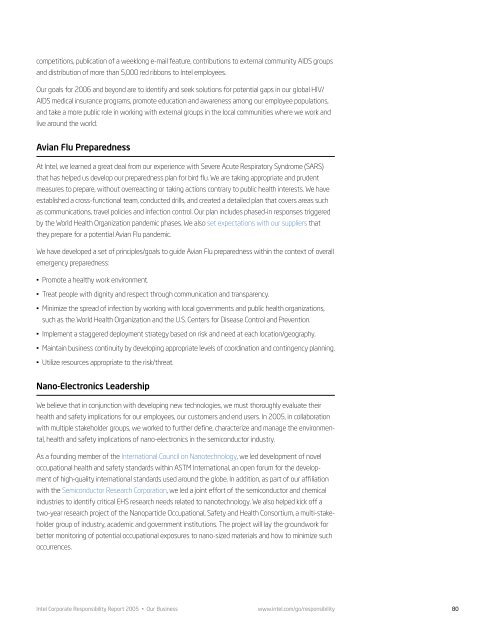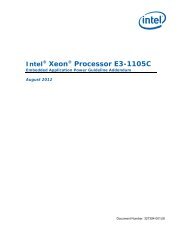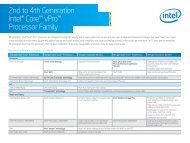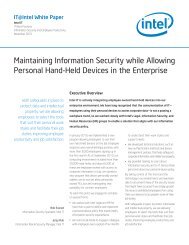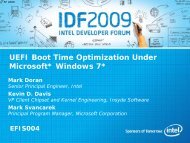Download - Intel
Download - Intel
Download - Intel
Create successful ePaper yourself
Turn your PDF publications into a flip-book with our unique Google optimized e-Paper software.
competitions, publication of a weeklong e-mail feature, contributions to external community AIDS groups<br />
and distribution of more than 5,000 red ribbons to <strong>Intel</strong> employees.<br />
Our goals for 2006 and beyond are to identify and seek solutions for potential gaps in our global HIV/<br />
AIDS medical insurance programs, promote education and awareness among our employee populations,<br />
and take a more public role in working with external groups in the local communities where we work and<br />
live around the world.<br />
Avian Flu Preparedness<br />
At <strong>Intel</strong>, we learned a great deal from our experience with Severe Acute Respiratory Syndrome (SARS)<br />
that has helped us develop our preparedness plan for bird flu. We are taking appropriate and prudent<br />
measures to prepare, without overreacting or taking actions contrary to public health interests. We have<br />
established a cross-functional team, conducted drills, and created a detailed plan that covers areas such<br />
as communications, travel policies and infection control. Our plan includes phased-in responses triggered<br />
by the World Health Organization pandemic phases. We also set expectations with our suppliers that<br />
they prepare for a potential Avian Flu pandemic.<br />
We have developed a set of principles/goals to guide Avian Flu preparedness within the context of overall<br />
emergency preparedness:<br />
• Promote a healthy work environment.<br />
• Treat people with dignity and respect through communication and transparency.<br />
• Minimize the spread of infection by working with local governments and public health organizations,<br />
such as the World Health Organization and the U.S. Centers for Disease Control and Prevention.<br />
• Implement a staggered deployment strategy based on risk and need at each location/geography.<br />
• Maintain business continuity by developing appropriate levels of coordination and contingency planning.<br />
• Utilize resources appropriate to the risk/threat.<br />
Nano-Electronics Leadership<br />
We believe that in conjunction with developing new technologies, we must thoroughly evaluate their<br />
health and safety implications for our employees, our customers and end users. In 2005, in collaboration<br />
with multiple stakeholder groups, we worked to further define, characterize and manage the environmental,<br />
health and safety implications of nano-electronics in the semiconductor industry.<br />
As a founding member of the International Council on Nanotechnology, we led development of novel<br />
occupational health and safety standards within ASTM International, an open forum for the development<br />
of high-quality international standards used around the globe. In addition, as part of our affiliation<br />
with the Semiconductor Research Corporation, we led a joint effort of the semiconductor and chemical<br />
industries to identify critical EHS research needs related to nanotechnology. We also helped kick off a<br />
two-year research project of the Nanoparticle Occupational, Safety and Health Consortium, a multi-stakeholder<br />
group of industry, academic and government institutions. The project will lay the groundwork for<br />
better monitoring of potential occupational exposures to nano-sized materials and how to minimize such<br />
occurrences.<br />
<strong>Intel</strong> Corporate Responsibility Report 2005 • Our Business<br />
www.intel.com/go/responsibility<br />
80


